RCyAF AIR DISPLAY IN 1963 – by Gp Capt Kumar Kirinde, SLAF (Retd)
Based on information and material provided by Capt Dhamseth Pallawela, Capt Gihan ‘GAF’ Fernando and Roger Thiedeman
On Sunday, October 6, 1963 the Royal Ceylon Air Force staged an air display at the Colombo Racecourse. In its December 1963 issue, British magazine Air Pictorial featured a comprehensive illustrated report of the show. A complete transcript of the article follows the page images below.
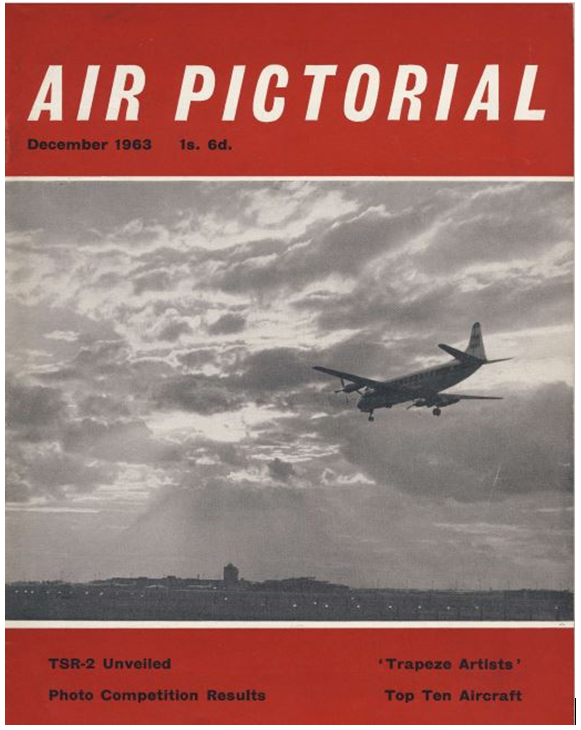
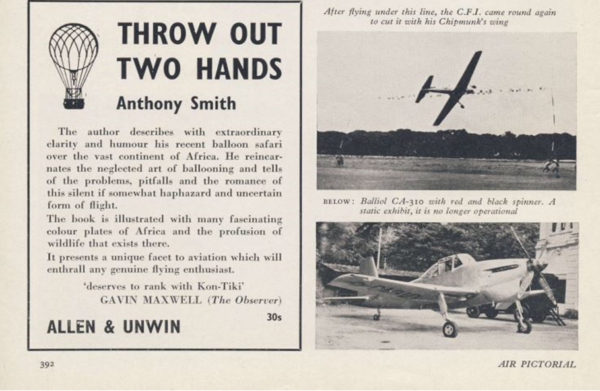
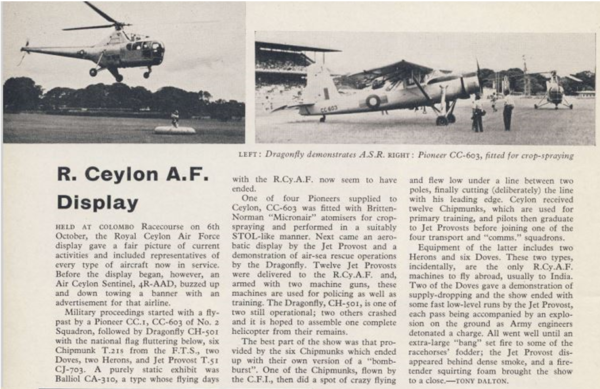
A transcript of the complete text of the report appears on the next page
Pics of Air Pictorial pages courtesy: Capt Dhamseth Pallawela
Royal Ceylon Air Force Display
HELD AT COLOMBO Racecourse on 6th October, the Royal Ceylon Air Force display gave a fair picture of current activities and included representatives of every type of aircraft now in service. Before the display began, however, an Air Ceylon Sentinel, 4R-AAD, buzzed up and down towing a banner with an advertisement for that airline. Military proceedings started with a fly-past by a Pioneer CC.I, CC-603 of No. 2 Squadron, followed by Dragonfly CH-50I with the national flag fluttering below, six Chipmunk T.2Is from the F.T.S., two Doves, two Herons, and Jet Provost T.51 CJ-703. A purely static exhibit was Balliol CA-3I0, a type whose flying days with the R.Cy.A.F. now seem to have ended. One of four Pioneers supplied to Ceylon, CC-603 was fitted with Britten-Norman “Micronair” atomisers for crop-spraying and performed in a suitably STOL-like manner. Next came an aerobatic display by the Jet Provost and a demonstration of air-sea rescue operations by the Dragonfly. Twelve Jet Provosts were delivered to the R.Cy.A.F. and, armed with two machine guns, these machines are used for policing as well as training. The Dragonfly, CH-501, is one of two still operational; two others crashed and it is hoped to assemble one complete helicopter from their remains. The best part of the show was that provided by the six Chipmunks which ended up with their own version of a “bomb-burst”. One of the Chipmunks, flown by the C.F.I., then did a spot of crazy flying and flew low under a line between two poles, finally cutting (deliberately) the line with his leading edge. Ceylon received twelve Chipmunks, which are used for primary training, and pilots then graduate to Jet Provosts before joining one of the four transport and “comms.” squadrons. Equipment of the latter includes two Herons and six Doves. These two types, incidentally, are the only R.Cy.A.F. machines to fly abroad, usually to India. Two of the Doves gave a demonstration of supply-dropping and the show ended with some fast low-level runs by the Jet Provost, each pass being accompanied by an explosion on the ground as Army engineers detonated a charge. All went well until an extra-large “bang” set fire to some of the racehorses’ fodder; the Jet Provost disappeared behind dense smoke, and a fire-tender squirting foam brought the show to a close. – TONY DALTON
Roger Thiedeman, aviation historian and writer, reminisces about the air display:
“…I was at that air display in 1963 and clearly remember every detail. It was a grey, overcast, humid, typical pre-monsoonal day, not ideal weather. But it didn’t interfere with the flying, and the huge crowd of spectators packing the grandstand, and at other vantage points in the vicinity of the Racecourse, were treated to a great show by Ceylon’s military aviators.
“One of two stand-out highlights for me was the Scottish Aviation Pioneer CC.1 landing on the infield of the racecourse and coming to a complete stop within a few metres of touching down. Then a minute or two later the throttle of the still-running Alvis Leonides radial engine was opened as the aircraft began ‘rolling’ and took off in an equally short distance, clearing the racetrack railings with plenty of lateral and vertical distance to spare. It was amazing stuff, and my first eyewitness experience of STOL performance.
“The other was the aerobatic display by the Chipmunks, especially the ribbon-cutting ‘stunt’ by one of the ‘Chippies’. Really exciting!”
*****
Some readers may be puzzled by Air Pictorial writer Tony Dalton’s reference to “an Air Ceylon Sentinel”. At the time, the only aircraft with which Air Ceylon was associated in most people’s minds were its fleet of three Douglas DC-3 Dakotas (4R-ACF, -ACG, & -ACI), and the ‘interchangeable’ Comet 4s used on BOAC/Air Ceylon pool partnership flights between Singapore and London via Colombo. So why an “Air Ceylon [Stinson] Sentinel”?
Capt. Gihan A. ‘GAF’ Fernando has the answer (with inputs from Roger Thiedeman):
“All the Ceylon Air Academy aircraft came under the Air Ceylon ‘umbrella’ when the Ceylon Air Academy was closed down on October 1, 1961.
“These aircraft, along with the Hiller UH-12B helicopter 4R-AAO (now at the Sri Lanka Air Force Museum at Ratmalana), were parked in a hangar adjacent to the main Air Ceylon hangar, on the east side of Ratmalana Airport, now known as ‘Hangar A’.
“Note that the banner towed by the Stinson L-5 Sentinel, 4R-AAD, says “Advertise Through Air Ceylon.” This announced that Air Ceylon-owned light aircraft, such as the Sentinel, could be hired by the public for such aerial advertising and promotional purposes. At the RCyAF air display 4R-AAD was flown by Capt. L.B. de Silva of Air Ceylon.
“On June 6, 1966, when a new Flying Training School was inaugurated by the government, two Austers (4R-AAJ & -AAM) and the twin-engine Aero 45 (4R-AAF) returned to flying training duties, along with a Chipmunk T.10 (4R-ACM; formerly CT-104 with the RCyAF) and Tiger Moth 4R-AAB*. The Commandant of the Flying School was Mr. Lionel Loos, Assistant Director of Civil Aviation (Aeronautical Inspection Directorate).”
(*By then the Stinson had been either decommissioned or already deliberately destroyed during the making of a feature movie in Ceylon by an European film company. But that’s another story for another time! – R.T.)
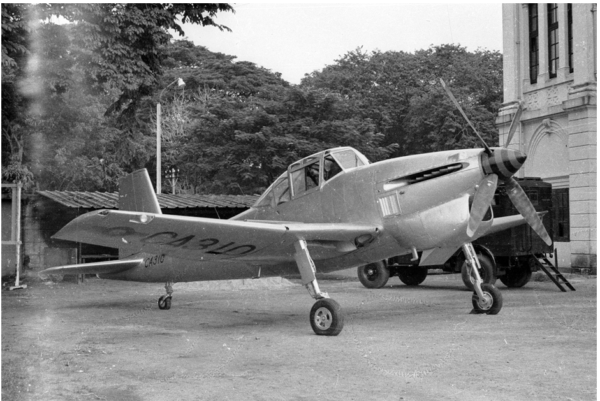 Boulton Paul Balliol CA-310 on static display behind the Racecourse grandstand
Boulton Paul Balliol CA-310 on static display behind the Racecourse grandstand
Pic courtesy: Capt Dhamseth Pallawela
THE 1963 RCyAF AIR DISPLAY IN PICTURES
(From the collection of Capt Gihan a. ‘GAF’ Fernando)
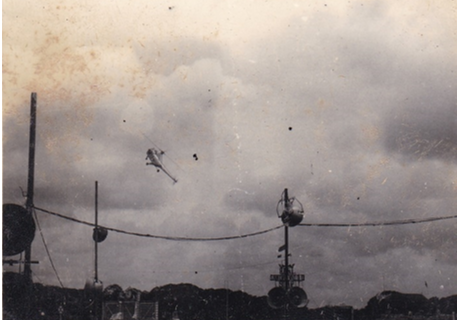
The Westland (Sikorsky S-51) Dragonfly flown by Fg Off Milroy A. de Zoysa.

A DHC-1 Chipmunk, flown by Fg Off Noel Lokuge, very close to the grandstand as it cuts a ribbon strung between two posts.

Two DH 104 Doves and two DH 114 Herons in formation.
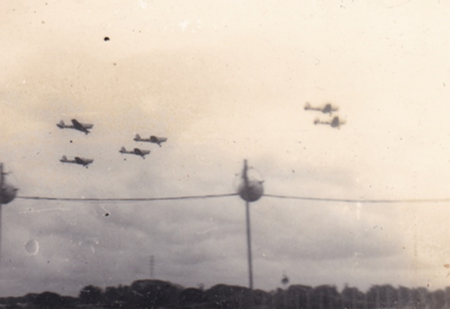
Six Chipmunks in formation. The wingtips of the two leading aircraft were tied together with a length of wool.
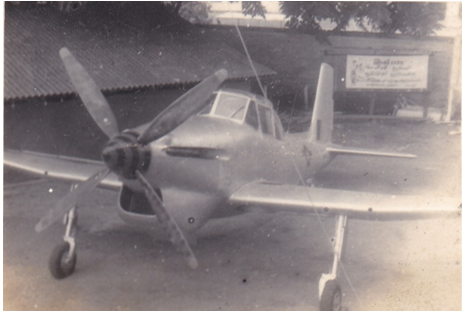
Another view of Boulton Paul Balliol CA-310 on static display behind the grandstand.
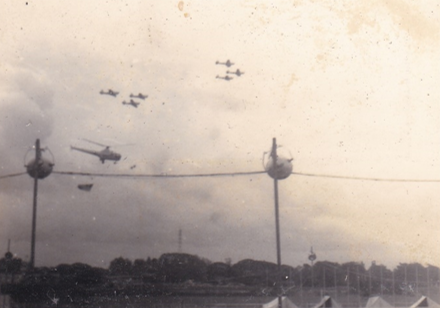
A ‘massed’ flypast by fixed-wing aircraft and Dragonfly helicopter.

Sqn Ldr Nihal Ratnayake performing a loop in a Jet Provost.
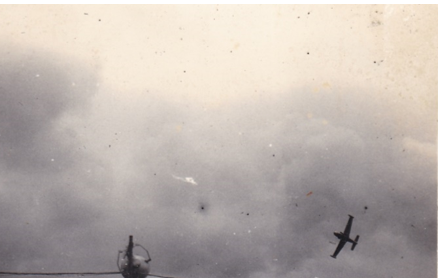
Sqn Ldr Nihal Ratnayake executing a four-point roll in the JP.
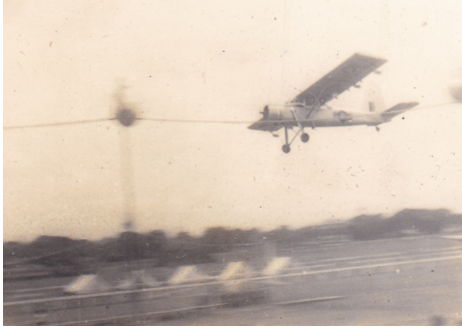
Fg Off Noor Rahim demonstrating crop-spraying by a Scottish Aviation Pioneer.
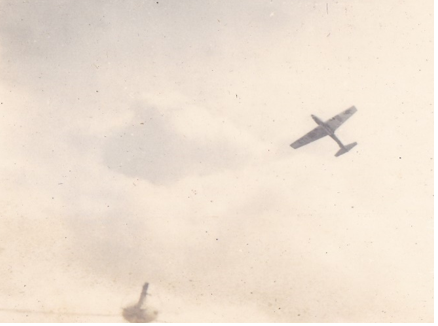
Fg Off Noel Lokuge demonstrates a ‘wing-over’ in a Chipmunk.

Air Ceylon Stinson L-5 Sentinel 4R-AAD towing a banner announcing ‘Advertise Through Air Ceylon’.
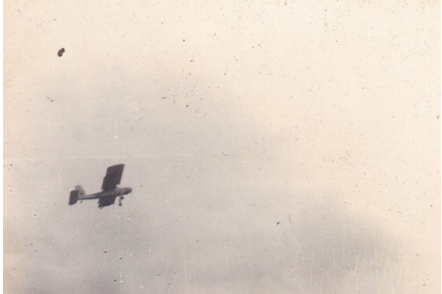
Scottish Aviation Pioneer demonstrating slow flight. For comparison, a bicyclist was pedalling along at the same speed!
************************
Note:
Ex-RCyAF pilots and other personnel who were serving at the time are requested to contribute personal anecdotes about the display – including details about planning, rehearsals, etc – for a subsequent follow-up e-Doc. Such contributions could be channeled to the compiler of this doc via email, slaf.rafoa@gmail.com
KWK_9-8-21







